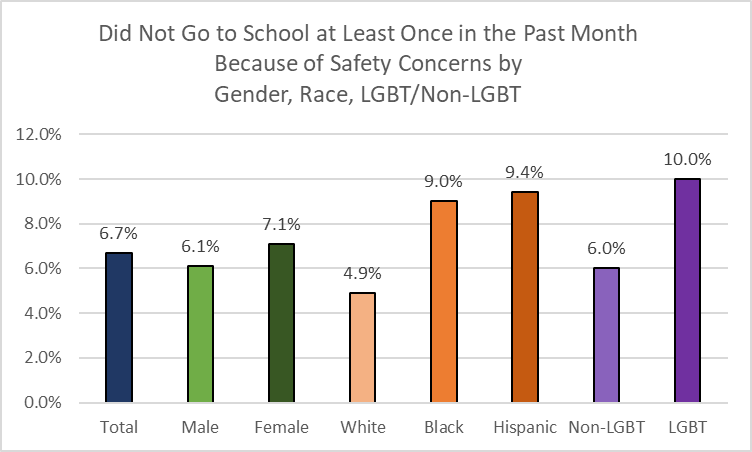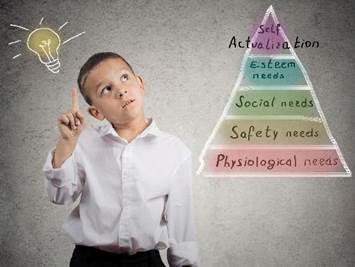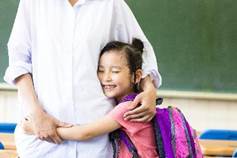
By: Julie E. McDaniel-Muldoon, PhD
Since the 1950s, American schools have been engaging in safety preparedness, beginning with fire drills, evolving into additional emergency protocols, and finally with active shooter training. Unfortunately, no evidence exists that these measures bring any improvements in the sense of safety. As Dr. Daniel Siegel (2015) explains, students need to be “seen, safe, and soothed, in order to feel secure” (p. 145), and these needs will not be met by current school safety practices alone. As collective wisdom considers the emotional and social impact of these current safety measures, it is important to note that for more than a decade, US students have been reporting how many of them miss school because of safety concerns. Karyn Purvis and her colleagues remind us, there is a difference between being safe and feeling safe: “Felt safety, which has to be determined by each individual, includes emotional, physical, and relational security” (From The Connected Child). It may be time to reconsider what is meant by school safety and to determine what our children and young people really need in order to feel the sense of safety required to thrive in school and beyond.
School Safety: A Perennial Issue for Some
Since 1999, the Center for Disease Control’s Division of Adolescence and School Health (CDC/DASH) has surveyed over four million US high school students on health behaviors that contribute to physical, social, and emotional problems. One of the questions addresses students’ sense of safety: “During the past 30 days, on how many days did you not go to school because you felt you would be unsafe at school or on your way to or from school?” From 2007-2017, 5-7% of US high school students have reported not going to school because of safety concerns. These troubling results have remained stable with no statistical difference across a decade.
Looking deeper into the 2017 results, females have significantly more safety concerns than males, and Black and Latino students have more safety concerns than white students. Additionally, LGBTQ+ students have significantly higher safety concerns than non-LGBTQ+ students. In a classroom of 30, two students stay home at least one day a month because they are afraid before, during, or after school.

The Neurobiology of Feeling Safe
Maslow’s Hierarchy of Needs is often held up as a framework for acknowledging both physiological and psychological needs in schools, especially with regard to safety. The premise is that basic human needs must be fulfilled before social, esteem, and self-actualization needs are considered. At the base of human needs are physiological needs, such as food and shelter. The next level of needs is focused on safety and security. This need for safety can be met with limits, consistencies, routines, and predictability. From there, efforts can be made to fulfill the needs for self-esteem and self-actualization. Using this model, schools might easily simplify the safety needs of their students and mobilize all adults in the schools to play pivotal roles in meeting these needs.

However, as Patricia Rutledge and others note, this understanding is too simplistic, because it fails to take into account the prerequisite for social connections at every level of the hierarchy. While it may not be included in current discussions, Maslow’s original model sets preconditions that do indeed recognize the social environment. The freedoms to speak and to defend one’s self are noted as preconditions, as are honesty, justice, and order in groups. Maslow (1943) asserts, “These conditions are defended because without them the basic satisfactions are quite impossible, or at least, very severely endangered” (p.384). According to Maslow, then, a healthy social environment is an imperative for meeting individual needs, including safety needs.
Considering the impact of the environment on individuals, Steven Porges (2017) explains feeling safe as a neurobiology in his Polyvagal Theory. The neurobiological responses to relationships and to the environment determine whether humans feel safe, and these instinctual responses take precedence over a cognitive determination of safety. Porges challenges the traditional structural ideas of safety that focus on physical measures as they may have no impact on the feeling of safety. In other words, the environment determines whether or not people feel safe, and feeling safe may not be based on logic or fact. Porges advocates a shift in thinking about safety that is a simple thought: it matters how people treat one another.
The Polyvagal Theory also asserts that feeling safe is the natural state of the brain. In this state, humans are connected and fully present. Because the brain perceives no risk, it is open to new learning. “Safe states are not only a prerequisite for social behavior, but also for accessing the higher brain structures that enable humans to be creative and generative” (Porges, 2017, p. 50). This theory suggests that all learning, academic and social-emotional, must happen in a perceived safe environment. As a by-product, then, in tending to the neurobiology of feeling safe, student achievement is likely to increase, as evidenced by several researchers who have seen the relationship between strong school communities that prioritize social-emotional learning with increases in student achievement (See the Collaborative for Academic, Social, and Emotional Learning, 2019; Hagelskamp, Brackett, Rivers, & Salovey, 2013, among others).

A Sense of Safety First
Rather than considering security measures and drills alone, improving school safety should focus on increasing the sense of safety, which happens within a healthy school environment. While physical safety measures are an important part of all safety plans, students feeling safe at school is not the same as an adult declaration that a school is safe. When students feel safe at school, they are more willing to engage in prosocial behaviors and their brains are ready to take in new information, be it academic content or social-emotional learning. Most importantly, when the focus is on students’ feelings of safety, it is possible to reduce the concerning numbers of students, especially Black, Hispanic, and LGBTQ+ students, who miss at least one school day every month because of safety concerns.
References
Collaborative for Academic, Social, and Emotional Learning. (2019). Research: SEL Impact. Retrieved from https://casel.org/impact/.
Center for Disease Control (2017). Youth Risk Behavior Survey: data and trends report 2007-2017. Retrieved from Washington, DC: https://www.cdc.gov/healthyyouth/data/yrbs/pdf/trendsreport.pdf.
Hagelskamp, C., Brackett, M. A., Rivers, S. E., & Salovey, P. (2013). Improving classroom quality with the RULER approach to social and emotional learning: Proximal and distal outcomes. American Journal of Community Psychology, 51(3-4), 530-543.
Maslow, A. H. (1943). A theory of human motivation. Psychological Review, 50, 370-396.
National Center for Education Statistics. (2016). Percentage of students ages 12-18 who reported being bullied at school during the school year, by type of bullying and selected student and school characteristics: Selected years, 2005 through 2015. In Bureau of Justice Statistics, U.S. Department of Justice, School Crime Supplement (SCS) to the National Crime Victimization Survey (Ed.), Digest of Education Statistics (August 2016 ed.). Washington, DC: NCES.
Porges, S. W. (2017). The Pocket Guide to the Polyvagal Theory: The Transformative
Power of Feeling Safe. New York: W. W. Norton and Company.
Purvis, K. B., Cross, D. R. & Sunshine, W. L. (2007). The Connected Child: Bring hope and healing to your adoptive family. In. New York: McGraw-Hill Education.
Rutledge, P. (2011). Social Networks: What Maslow Missed. Retrieved from https://mprcenter.org/blog/2011/11/social-networks-what-maslow-misses/
Siegel, D. J. (2015). Brainstorm: The Power and Purpose of the Teenage Brain. New York: Jeremy P. Tarcher/Penguin.
About the Author:
Julie E. McDaniel-Muldoon, PhD
- Social Media Director, International Bullying Prevention Association (IBPA)
- Student Safety and Well-Being Consultant, Oakland Schools (Waterford, Michigan)
- Advanced Practitioner and Trainer, Starr Global Learning Network/National Institute for Trauma and Loss in Children (TLC)
- Email: julie.mcdaniel@oakland.k12.mi.us
- Blog: https://jemmuldoon.blogspot.com/
- Twitter: @jemmuldoon
